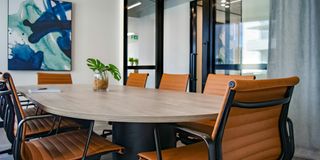Prime
Essential factors to consider when selecting office furniture

Select furniture made from high-quality materials such as solid wood or metal for durability and timeless elegance. PHOTOs/unsplash.com..
What you need to know:
To create a conducive working environment for employees select furniture that supports their well-being. Look for furniture that is functional and suitable for your work.
In today’s dynamic work environment, creating conducive workspace is essential, whether it is in a corporate office or the comfort of your own home. As the lines between work and living spaces continue to blur, selecting the right office furniture becomes paramount. From executive desks to simple workstations and boardroom tables, every piece plays a crucial role in fostering efficiency, comfort, and style.
Selecting office furniture goes beyond mere aesthetics; it is about creating a conducive environment that fosters productivity, creativity, and well-being. By understanding the unique needs of your workspace, you can curate a functional and stylish office setting that enhances both work performance and overall satisfaction.
Boardroom tables
In a corporate setting, the boardroom serves as a hub for collaboration and decision-making. David Opio, a creative designer in Kampala says, the boardroom table, as the focal point of the office space, should facilitate communication and inspire creativity. When selecting a boardroom table, consider factors such as size, shape, and material to accommodate different meeting styles and preferences.
“Boardroom tables should promote inclusivity and engagement among participants. Opt for modular designs that can adapt to various group sizes and configurations, allowing for seamless collaboration and brainstorming sessions,” Opio says.
Chairs
No office furniture collection is complete without the perfect chairs. Whether it is for executive suites, workstations, or conference rooms, choosing the right chairs is essential for maintaining comfort and productivity. Look for ergonomic features such as adjustable height, lumbar support, and breathable materials to support long hours of sitting.
According to Opio, investing in ergonomic chairs is crucial for promoting good posture and preventing musculoskeletal issues.
“Prioritise comfort without compromising on style, and opt for chairs that encourage movement and proper alignment,” he advises.
In the boardroom, seating arrangements are just as crucial as the table itself. Boardroom chairs should strike a balance between comfort and executive presence, ensuring that participants can focus on discussions without distractions.
“Boardroom chairs should convey professionalism while prioritising comfort for extended periods of sitting,” says Opio. “Consider options with adjustable features, such as height and recline, to accommodate diverse preferences and ensure optimal comfort for all attendees,” he adds.
Desks
A desk is a cornerstone of any executive office. An executive desk is more than just a piece of furniture; it is a symbol of authority and professionalism. When choosing an executive desk, consider not only its aesthetic appeal but also its functionality. Look for features such as ample storage, built-in cable management, and ergonomic design to enhance productivity and comfort during long hours of work.
Johnson Kabasa, a decor expert says an executive desk should reflect the individual’s personality and work style while also displaying sophistication and professionalism.
“Select high-quality materials such as solid wood or metal for durability and timeless elegance,” Kabasa says.
Simple desks
For those seeking a more minimalist approach, simple desks offer a versatile solution that combines form and function. Ideal for smaller spaces or home offices, these desks prioritise clean lines and practicality without sacrificing style. When selecting a simple desk, focus on its ergonomic design and storage options to maximise efficiency and comfort.
Kabasa emphasises the significance of simplicity in office furniture. “Simple desks provide a clean canvas for creativity while promoting a clutter-free workspace.Choose designs that complement your decor and allow for easy integration of technology, such as built-in charging stations and cable management systems,”he says.
Desk layout
In work spaces, the ergonomic design of a desk and chair can affect an employee’s physical comfort and health. Uncomfortable or poorly designed furniture can lead to discomfort, musculoskeletal issues, and decreased productivity. A well-designed workspace with adjustable chairs and ergonomic accessories can enhance comfort and productivity.
While design and layout of a desk have a multifaceted impact on employee productivity, the ideal desk layout depends on the specific needs of the organisation and its employees, taking into consideration factors such as job roles, tasks, and the work culture.
Hakimuddin Sabunwala, director at Mystique Developers Limited, says different types of desks can be used in various offices depending on the needs and preferences of the employees and the overall office design. They include:
Standard desks: These are also called rectangular desks and are the most common desks found in offices. They have a standard rectangular shape with a flat surface, providing ample workspace for tasks and equipment.
L-shaped desk: L-shaped desks are designed to fit in the corner of a room, providing an extended surface area and offering more workspace. Sabunwala says that these are ideal for employees who need to multitask or have multiple monitors or documents.
Standing desks: Sabunwala notes that these have become increasingly popular, “They allow users to alternate between sitting and standing throughout the day, promoting better posture, reducing sedentary behavior, and improving focus and productivity,” he explains.
Proximity
If employees frequently need to access a printer, office supplies, or shared equipment, their productivity may suffer if these resources are not easily accessible. The desk layout should consider the proximity of resources needed for the job. Therefore, the ability to adjust and adapt the desk layout to accommodate different tasks and work styles is crucial.




